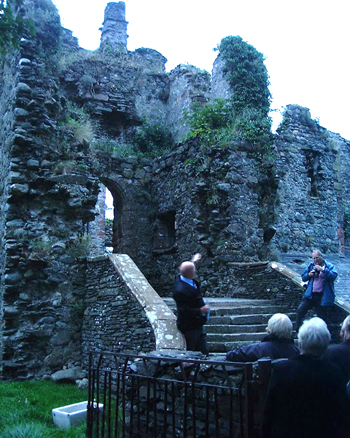
 |
 THE
battlements that once kept 13th century marauding Scots out of Copeland have
crumbled into one of the area's best-kept secrets. Unlike other castles that
echo to the tread of tourist visitors, Millom castle only echoes to the sounds
of tractors and of beef cattle chewing the cud.
THE
battlements that once kept 13th century marauding Scots out of Copeland have
crumbled into one of the area's best-kept secrets. Unlike other castles that
echo to the tread of tourist visitors, Millom castle only echoes to the sounds
of tractors and of beef cattle chewing the cud.
For the castle, with historic links to the knights who fought at Agincourt,
is in private ownership and is at the core of a working farmstead overlooking
the town of Millom. The great halls and moated castle ruins enclose a 32-roomed
pele tower style home to the current owners, the Park family.
On one of the rare recent public tours of the castle, Blue Badge guide for the
Tourist Board, Tom McGafferty, proved he certainly knows his history and inside
the former great halls of the castle he talks of the castle's past.
"Before the Norman invasion, Goddard de Boyvill was at the age of 21 granted
the Lordship of Millom after he accompanied the Baron of Copeland on the crusades,"
he says. "De Boyvill had absolute power of life and death in the area and
if you had come across the Duddon in those days the first thing you would have
seen near the foreshore was the hangman's gibbet.
"Eventually the castle passed into the Huddleston family. The Huddlestons
mixed with Royalty - one fought at Agincourt and another was one of the knights
who murdered Edward II's alleged gay favourite, Piers Gaveston, in 1312. The
Millom knight was soon afterwards pardoned for his part in this political murder."
It was in this era that Robert the Bruce trounced the English at Bannockburn.
Henceforth Bruce was sure of his position as King of Scots, took vengeance for
Edward I's activities by devastating the northern counties of England, and basically
assured a continuation of the war between England and Scotland for the next
300 years.
The castle at Millom had a portcullis, drawbridge and 30ft wide moat to repel
these Scottish attackers. Tom recalled the old Millom saying from those days
of Scottish cattle raiding and slaughter: "Nowt of any good comes around
Black Combe" (a reference to the mountain between Millom and the north).
The moat can be clearly seen between the back of the castle and adjoining Holy
Trinity church.
In the Huddleston chapel are two tombs. The dramatic alabaster monument from
1494 commemorates Richard Huddleston, and on it are his effigy in armour ready
for any eventuality, and that of his wife Lady Mabel Dacre.
The castle appears to have suffered significant damage by attacking Lancastrian
forces in around 1460. In 1644 during the Civil War it was captured by Parliamentarian
forces. Repairs were made in 1670, but the castle was in ruin again by 1739.
Mr McGafferty said records relating to Millom castle were sometimes thin on
the ground, so there was uncertainty surrounding the various periods. But despite
the Roundheads' attack much of the ancient castle remains stubbornly intact.
Often helping Tom show visitors around the castle is the youngest potential
"successor" to the castle - young Josef Park, aged nine.